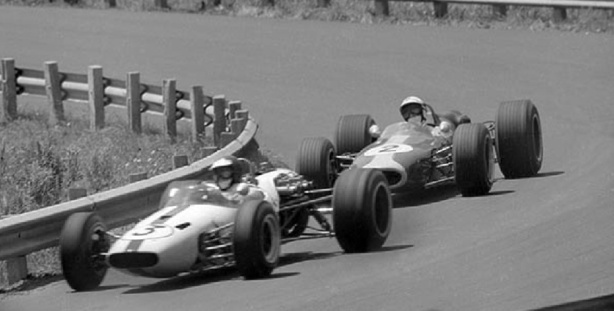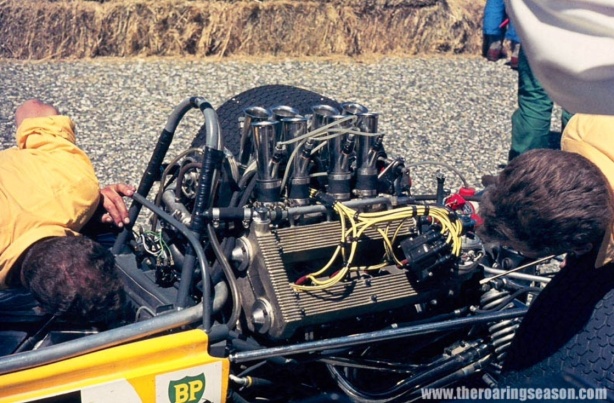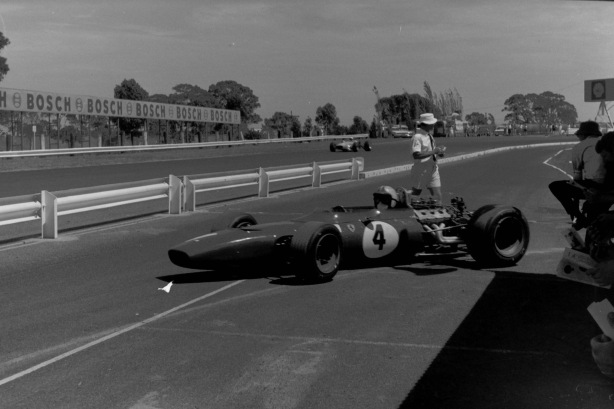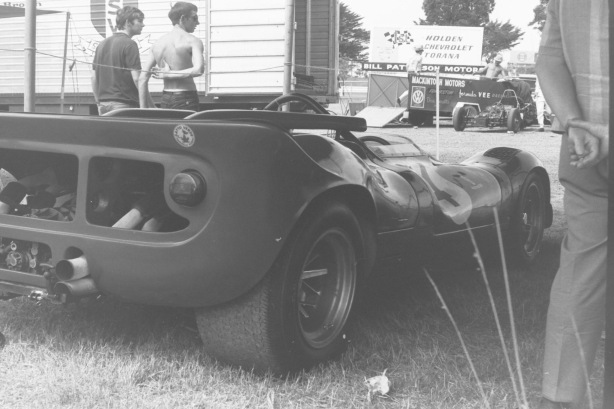
Frank Gardner takes the chequered flag after winning the December 3, 1967 Hordern Trophy, traditionally the season ending Gold Star round at Warwick Farm…
Frank’s habit was to finish his European racing season and then head back to his home city, Sydney, and contest the final Gold Star round as a warm up for the seven or eight round Tasman Series which followed in January/February.
He raced the event for Alec Mildren Racing from 1965 to 1968, winning two of the four events in the Brabham BT23D Alfa in 1968 and Brabham BT16 Climax FPF in 1966. He led the 1968 race in the Mildren Alfa Yellow Submarine but pulled out with fuel metering unit problems. His other start was in Alec’s Brabham BT2 Ford/Lotus twin-cam 1.5 in 1965, his 1965 Tasman mount, for the sake on completeness was a Brabham BT11A Climax which was not ready at the time of the Hordern.

Gardner in The Esses (oldracephotos.com.au/Phillips)

Bartlett cucking the BT11A around in the style which always made him a crowd pleaser- and quick. This car was at the end of its third full season of racing in late 1967- debut by Gardner in the 1965 Tasman (oldracephotos.com.au/Phillips)
The 1967 Hordern Trophy was disappointing in a way, that year Spencer Martin and Kevin Bartlett slugged out the Gold Star in identical Brabham BT11As; Spencer’s was owned by Bob Jane and KB’s by Alec Mildren. Click here for more; https://primotipo.com/2018/04/27/kbs-first-bathurst-100mph-lap/
Bartlett had to win the penultimate round at Symmons Plains the month before, November 12, to stay in the hunt at the Hordern, while he led in Tasmania, a broken oil line ruined his chances. Greg Cusack took the win in David McKay’s Brabham BT23A Repco from John McCormack – not really racing outside Tasmania at that stage – in his ex-Jack 1962 Caversham AGP mount, a Brabham BT4 Climax, and David Sternberg’s Alexis Mk6 Ford ANF1.5.
Martin won the Gold Star at Symmons despite failing to finish, observing a self-imposed 6800 rev limit, he had cam-follower failure. As already planned and announced, he retired. John Harvey took the seat from the Hordern Trophy, racing very successfully for Bob Jane for the next five or so years in a range of single-seaters, sportscars and tourers.

(oldracephotos.com.au/DKeep)
Martin above, and Bartlett below before the off at Symmons, Brabhams BT11A times two.
In the preliminary, KB led Spencer and Greg away with Cusack up to second before being clobbered by a rock in his visor, Martin retired with a duff plug, KB took the win.
In the main race Kevin led until lap 12, from Cusack and Martin before the oil line broke. After Glen Abbey fixed the problem KB gave the crowd a show by taking to the circuit and driving the last 34 laps flat-knacker, dropping the lap record to 56.4 seconds and being rewarded with a point.

(oldracephotos.com.au/DKeep)
The Repco V8 engined Cusack car, Jack Brabham’s 1967 Tasman machine, Leo Geoghegan’s ex-Clark Lotus 39, or John Harvey’s Ron Phillips owned, converted F2 Brabham BT14, all powered by 640 or 740 series 2.5-litre V8’s coulda, shoulda taken the Gold Star from the Climaxes that year but unreliability prevented them doing so. And the sheer, raw pace of Martin and Bartlett.
Leo Geoghegan was so miffed with his Repco engine he fitted a Coventry Climax back into his Lotus for the Hordern Trophy, that didn’t work for him either, he was outed with overheating despite a good third grid position.

Greg Cusack sussed his tyres with the Firestone man during the Hordern Trophy weekend. Scuderia Veloce Brabham BT23A Repco

Leo Geoghegan at Longford in March 1967- just before John Sheppard and Bob Britton converted the ex-Clark Lotus 39 from Coventry Climax FPF to Repco 640 V8 power (oldracephotos.com.au/Harrisson)

(RCN)
This race summary draws heavily on Peter Wherrett’s January 1968 RCN coverage and that of Australian Autosportsman’s Ray Finnerman and Warwick Robbins. There were some amazing differences in the reports, where there were such the Wherrett view is my favoured one!
Gardner started the Hordern from pole having done a 1:29.6 seconds, the only man under 1:30.
KB jumped into an early lead but Gardner passed his teammate going into the Northern Crossing, and led for the balance of the 45 lap journey in an impressive display in what was a brand-spankers, new car.

Bartlett and a couple of other cars have just cleared the Western Crossing on the first lap- KB, Gerdner, Harvey, Stewart, Geoghegan, West, Gibson, Cooper out wide at left and the rest with Cusack well back (DBird/RCN)
KB ran very hard in second place leading Harvey and Geoghegan in Climax cars, Stewart’s ANF1.5 Rennmax BN1 Ford Twin-cam and the Repco engined Cusack Brabham who was making up ground hand over fist as a consequence of missing dry practice; he boofed the car at The Causeway which required workshop repair.
After Cusack came Phil West in Mike Champions’ ‘old chassis Brabham’ BT2 ANF1.5, Fred Gibson in Niel Allen’s ex-Gardner Brabham BT16 Climax, Glyn Scott, Lotus 27 Ford, Garrie Cooper, Elfin Mono Mk2D Ford, Alf Costanzo, Elfin Mono Mk2B Ford, Alex Lazich, Pirana Ford 1.1, Brian Page Elfin Mono Mk1 Lancia V4 and Milton Lambert, Elfin Mono Mk1 Ford.
“The spins came early with Costanzo who got the ball rolling with a big one on the second lap…Cary, Elfin FJ Ford 1.1 was having troubles of his own and was in the grass more than once early in the race and dropped back to last place” wrote PW.

Alf Costanzo, Elfin Mono Mk2B Ford gives Bartlett plenty of room into The Esses (oldracephotos.cm.au/Phillips)

Cusack took a win in the single-seater support during the AJC Trophy meeting at Warwick Farm in July 1967- beautifully on line here at Homestead Corner, Brabham BT23A Repco
So it was Gardner comfortably from Bartlett, he too not being hard pressed by Harvey and Geoghegan, Stewart, Cusack and Phil West.
Max comfortably led the ANF1.5’s and led that title chase. The ANF1.5 Championship was run concurrently with the Gold Star rounds to ensure adequate fields of both, especially the 2.5’s which were thin on the ground outside the Tasman Series.
Greg bagged Max on lap 3, “Cusack’s Repco V8 sounded great and he was noticeably faster than all but Gardner and Bartlett,” wrote Wherrett.
Stewart lost his clutch on the fifth lap from which point West was all over him.
By lap 9 FG led from KB by thirteen seconds in turn still well ahead of Harvey who ‘was very at ease with the old Martin car and was enjoying the renowned Climax reliability’. The latter comment probably a dig at the difficulties Harvey, Phillips and Peter Molloy had with the Brabham BT14 F2 car, converted earlier that year from 1760cc Ford Twin-Cam to 2.5-litre 640 Repco V8 form.
I know from comments made by (the late) Harves on social media in recent years that the team did get the BT14 going very quickly once the suspension was fully sorted- to the extent of a single-seater feature race ‘Diamond Trophy’ win at Oran Park and good race/qualifying pace in the Surfers, Sandown and Mallala Gold Star rounds. In fact I see his qualifying time at the first Gold Star round at Lakeside in June was just under 1.5 seconds away from Cusack’s pole time, so arguably the thing was thereabouts in pace, if not reliability pretty much from the start.
Quite why Bob Jane, who bought the BT14 Repco from Ron Phillips, then pulled the engine and ‘box from the then sorted, fast BT14 and plonked them into the back of the BT11A for the ’68 Tasman only for Harvey to go through the sorting process all over again makes no sense to me at all.
Back to the Farm.
Cusack passed Geoghegan who shortly after spun on some lose stuff in The Causeway. After another spin he gave up the battle with overheating and handling problems, when Leo departed the race after 11 laps he was piped-out by Creek Corner’s famous trumpeter who played the Last Post!

Gardner from the Elfin Mono (oldracephotos.com.au/Phillips)

John Harvey, Brabham BT11A Climax monstering Fred Gibson in Niel Allen’s ex-Gardner Brabham BT16 Climax. The Esses (oldracephotos.com.au)
Alfie spun on laps 14 and 16, Glyn Scott had a loop on lap 11 losing his spot to Elfin Chief GC Cooper Esq. Clearly there was a lot of muck on track- perhaps due to the rain the day before.
With plenty going on for the spectators, Fred Gibson pitted the Allen Brabham BT16 with braking problems on lap 14. The brake line had severed so the crew sent him out 5 laps later after the rear brakes were disconnected. Brave boy.
Cusack closed within four seconds of John Harvey, then spun at The Causeway without hitting anything this time, he didn’t lose a place in the process but had to do the hard work to bridge the gap to Harves all over again.
By now Phil West had passed Max Stewart but that was not a drama for The Big Fella from Orange, he had the points needed to bag the first of his many national titles.
With Gardner up front of Bartlett by about a half minute the Alfa Romeo V8 sung its song impressing all with its speed- FG tickled the thing into some delicate slides demonstrating the chuckability for which these Brabhams were famous.

‘Bartlett’s Brabham buried deeply in straw and Armco after its Causeway lose. Surprisingly the car was not badly damaged- nor was Bartlett. But he was sure annoyed! wrote Wherrett (D Bird/RCN)
Then KB lost it going into Polo on lap 27- the engine cut out and by the time he got going again he was back to fourth. “Then he did it again and it seemed the engine was going cold between gear changes” is Wherrett’s somewhat mysterious observation. Bartlett covered one more full lap without drama but then got onto some of the lose stuff and charged straight ahead through the straw bales and into the Armco.
So John Harvey was up to second place keeping a good eye on Cusack further back, the Canberra motor dealer narrowed the gap down to five’ish seconds but then had another spin, at Polo and this time put Harvey beyond his reach in the remaining laps to the finish. Wherrett reported that Harves had a half-lose in The Causeway too, but he caught it and drove to the finish behind Gardner.
West and Stewart diced hard for the balance of the race, Phil getting over the line only “with a lead of only one second” from Max- I notice the oldracingcars.com result credits West with 43 laps and Max 42- whatever the case it was a very fine showing by West who had stepped up from an FJ/F2 1100cc car to a Ford/Lotus Twin-Cam powered ANF1.5 for the very first time at this meeting.
Within months he was offered the Scuderia Veloce Brabham BT23A Repco seat vacated by Greg Cusack after his high speed 1968 Longford Tasman shunt hospitalised him and hurt him badly.

Phil West, Brabham BT2 Ford 1100cc, at Oran Park during 1967 (D Simpson)

Phil West on the way to a Bathurst 100, Easter Bathurst Gold Star win in 1969- Scuderia Veloce Brabham BT23A Repco (P Cross)
When Gardner passed Harvey on lap 42 he had lapped the field, at the end of the race there were only two he hadn’t lapped twice.
FG won by a lap and 1.8 seconds from John Harvey in a very strong first race for Jane, Brabham BT11A Climax, then came Cusack, Brabham BT23A Repco a minute behind Harvey, a lap ahead of West, Brabham BT2 Ford, Stewart, Rennmax BN1 Ford and Costanzo, Elfin Mono Mk2B Ford. Then came Garrie Cooper, Elfin Mono Mk2D Ford, Glyn Scott, Lotus 27 Ford, Brian Page Elfin Mono Mk1 Lancia and Fred Gibson, Brabham BT16 Climax to round out the top ten.


FG with the Hordern Trophy- grand isn’t it!?
And on the Ferrari lap of honour below with friend and long time Mildren engineer/mechanic Glenn Abbey alongside- is that the flat-capped Alec in the passenger seat perhaps. Ferrari 275 GTS maybe.

There were three future Gold Star Champions in this race- KB, Max and Alfie. That the 1.5’s were so well up is indicative of the paucity of 2.5 machines outside the Tasman.
Gardner was probably feeling pretty good about his 1968 Tasman chances that day, but the competition was tough that year; Clark and Hill in Lotus 49 Ford’s, Amon’s works Dino V6, two BRM’s both P261 V8 and P126 V12 driven by Rodriguez, Irwin, Attwood and others, lets not forget Piers Courage’ F2 McLaren M4A Ford FVA.
I guess the Light Car Club’s annual Victorian Trophy which pre-dates the Gold Star, first held in 1957, and the Hordern Trophy awarded by the Australian Automobile Racing Club were the most prestigious and longest lived of the Gold Star awards?
Sydneysiders are well aware of the enormous wealth generated by the Hordern family who arrived as free-settlers in in the mid-1820’s and grew an enormous retail empire from their first Mrs Horderns drapery store at 12 King Street.
At its height the massive Anthony Hordern and Sons Ltd ‘The Palace Emporium’, built in 1905, occupied a whole Sydney block bounded by George, Liverpool, Pitt and Goulburn Streets. The company employed over 4,000 and dealt in ‘everything from a needle to an anchor’ which were either made in its Sydney factories or imported by its agents. The company was taken over by Waltons Ltd in January 1970.

Sir Sam Hordern (1876-1956) was an early member of the Royal Automobile Club of Australia and twice its President. The RACA Club Trophy was introduced by Sam Junior to coincide with the opening of Warwick Farm. It was contested throughout the sixties with ‘traditional events at Wallacia (hillclimb) and standing quarter mile tests at Castlereagh Airstrip’ whilst simultaneously the Sam Hordern Trophy, usually abbreviated to Hordern Trophy was provided to the winner of the AARC’s Warwick Farm Gold Star event.

Bib Stillwell in a year he didn’t win! 1964 Hordern Trophy, Brabham BT4 Climax DNF lap 15 with Coventry Climax engine failure. The ANF1.5’s of Leo Geoghegan and Greg Cusack, Elfin Catalina Ford led the field home (B Wells)

The other three-time Hodern Trophy winner, Kevin Bartlett, in Alec Mildren’s Brabham BT23D Alfa Romeo, he also won the Gold Star in this machine in 1968 (unattributed)
There were twelve Hordern Trophy events from 1961 to 1972, Bib Stillwell won the first in a Cooper T53 Climax F Libre and Frank Matich the last in his Matich A50 Repco F5000.
Stillwell and Bartlett won three times, Gardner and Leo Geoghegan twice, with singleton wins for John Youl and Matich. The winningest marque was Brabham with four chequered-flags, the engine with the most notches in its sump was the good ‘ole Coventry Climax four-cylinder, DOHC FPF with five victories.
Late lamented Warwick Farm’s last open meeting was the July 15, 1973 Australian Touring Car Championship meeting, and the very last an AARC Clubbie on the Farms short circuit, August 12, 1973.

Peter Brock, Holden Dealer Team Group C Holden Torana GTR-XU1 during the final WF open meeting- the final round of the 1973 Australian Touring Car Championship on 15 July which Brock won from the similar Torana of Bob Morris and Pete Geoghegan’s Valiant Charger RT E49 (unattributed)
Etcetera: Brabham BT23D Alfa Romeo…
Brabham BT23D ‘1’ was a one-off car built on Ron Tauranac’s F2 BT23 jig to the specific requirements of Alec Mildren- specifically fitment of an Autodelta Tipo 33 2.5 litre engine.
Mildren was an Alfa dealer, the new motor allowed him to join the Tasman V8 brigade and get some promotional rub-off in terms of car sales.
The car was built in the Motor Racing Developments factory in Weybridge with the engine installation carried out the Mildren Racing ‘shop in Sydney by Glen Abbey and the team. The Brabham BT23 family of Tasman cars is covered in this article;
Bathurst 1969 and Jack’s Tasman Brabham Repcos…

The car had a multi-tubular spaceframe chassis with conventional outboard suspension front and rear. Wishbones top and bottom at the front with coil spring damper units and an adjustable roll bar. At the rear was an inverted lower wishbone, single top link, two radius rods and again coil spring/dampers and an adjustable ‘bar. Suspension uprights were cast magnesium front and rear- the front Alford and Alder units were given the flick with the introduction of the BT23!

(M Feisst)
The engine was a beauty and came to Mildren via Autodelta’s long Tipo 33 sportscar program which ran well into the mid-seventies and yielded an F1 flat-12 engine along the way; not to forget 3-litre F1 versions of the T33 V8s.
Kevin Bartlett has said Mildren had three of the V8’s along the journey from late 1967 to late 1970, which were fitted to the Brabham BT23D and Len Bailey designed, Alan Mann Racing built Mildren Yellow Submarine, the monocoque jewel which succeeeded the Brabham (as in Gardner’s 1969 Tasman weapon and KB’s car for the 1969 Gold Star and beyond- and ultimately fitted with a Waggott TC-4V 2-litre moteur).
Engine number ‘AD001’ was variously quoted at 2,464 and 2,472cc and was a 90 degree, DOHC, chain-driven, two-valve, twin-plug, Lucas injected, Marelli sparked V8 giving around 285 bhp; about the same as was quoted for Amon’s Dino in three-valve spec in 1968 (yes he raced four-valvers in Australia in 1968 too).
The gearbox was the ubiquitous Hewland FT200 five-speeder.

Teretonga- BRM’s Tim Parnell (seated) grabs a Coke with the Mildren lads- wonder who the cutie is at left? Front and rear suspension as per specs in text below. A beautiful bit of kit which FG exploited to the full (Ian Peak)
Arguably the BT23D Alfa was the best car Gardner ever drove in a Tasman, the ‘Sub’ was a better car but was neutered in part by its sub-optimal wing package in 1969.
Frank’s problem was the depth of the 1968 field too. With Clark, Hill, Amon, Hulme (emasculated with an F2 Brabham BT23 that summer) Rodriguez and Brabham, albeit Jack only did some of the Oz rounds, his race record, in that context is strong.
Pukekohe (NZ GP) Q4 and second. Levin Q2 and DNF after running wide on the fast sweeping left-hander, boofing the car and damaging the suspension after hitting a bank. Wigram, Q3 on the airfield circuit and DNF head-gasket. Teretonga, Q4 on the world most southern track and third.
Off to Australia.
Surfers Q4 and DNF- not sure why. Warwick Farm Q8 and DNF camshaft. Sandown Q6 and fourth. Longford, his qualifying time is not clear in the shemozzle over starting the sodden race but third was a good race result.
Gardner flirted with Grand Prix racing, he was happier doing a mix of touring cars, sports prototypes, F2 in most years, some F1 and an annual Tasman summer. He did great against the greatest, lets not forget the Lotus 49 Ford is one of racing’s greatest GP cars, Amon’s Dino was a works machine too, run by Amon’s local Kiwi crew.
It would have been very interesting to see how FG would have gone in a decent GP car, circa 1966 to 1969 when he was in his peak.
As it was BT23D gave Bartlett his first of two Gold Stars, the Sub the other. Then it became ‘our first F5000’ car when Jim Abbott bought it from Mildren and gussied it up as such as a display car to promote the class he believed in.
Into hill-climbing the chassis was modified and used by Abbott. Later Chris Murphy died in it at One Tree Hill, Ararat. Eventually restored by Paul Moxham, beautifully so too, the car now lives in Tasmania owned by the sympathetic Chas Kelly. The full history of the car is a topic for another time.
More on Alfa’s race 2.5 V8’s here; https://primotipo.com/2018/11/30/motori-porno-alfa-romeo-tipo-33-tasman-2-5-litre-v8/
Etcetera: Symmons Plains Gold Star 1967…

(oldracephotos.com.au/DKeep)
Greg Cusack confers before the off. His only Gold Star win was that day at Symmons, in some ways Greg’s small-bore single seater promise was not fulfilled in BT23A results.

(oldracephotos.com.au)
Cooper in the ‘ultimate spec’ Mono- his factory outboard suspension Mk2D. GC used this chassis and a 600 to jointly win the ANF1.5 title shared with Max Stewart in 1968.

(oldracephotos.com.au/DKeep)
Credits…
oldracephotos.com.au, Royal Automobile Club of Australia, oldracingcars.com, Australian Autosportsman, Dick Simpson, Mike Feisst and Ian Peak on The Roaring Season, Paul Cross, Racing Car News, D Bird, Ray Bell
Tailpiece: All Australian boy and all round sportsman…

Lakeside, during the Australian Tourist Trophy meeting in 1965 (Ray Bell)

(Fairfax)
The black and white version, almost, of the opening photo which is ripped off from the cover of FG’s ‘Castrol Racing Drivers Manual’!
Finito…




























































































